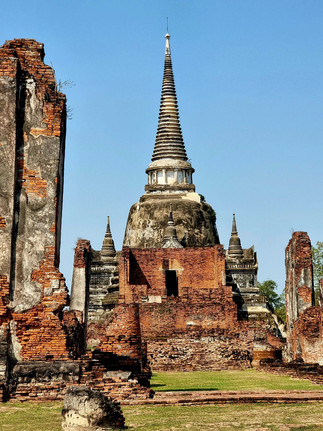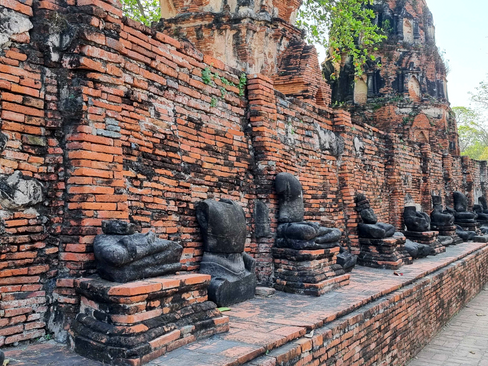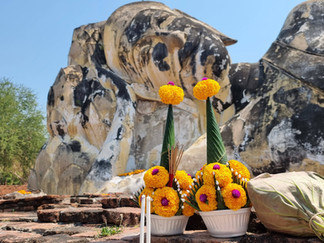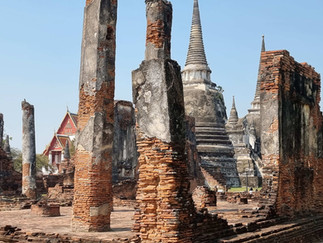Ayutthaya - The Fallen City of Siam
- Shannon
- Sep 16
- 4 min read
The Kingdom of Ghosts and Forgotten Kings
Once a vibrant and influential hub, this ancient metropolis was founded in 1350 by U-Thong (later crowned Ramathibodi I) and became the second capital of the Siamese Kingdom. For more than four centuries, it thrived as a cosmopolitan powerhouse, rising to global prominence as a centre for commerce, diplomacy and culture. Its strategic location attracted traders from China, India, Persia and Europe, transforming it into one of the largest, wealthiest and most advanced cities in the world during its golden age.

This trio of ancient chedis contain the ashes of King Trailok, King Borom Ratchathirat III, and King Rama Thibodi II
Strategically nestled on an island in the Chao Phraya River valley, the old capital of Siam was naturally fortified by the convergence of three rivers, creating a formidable defense against invaders while offering direct access to the sea. This unique geography not only safeguarded the city but also positioned it as a key maritime hub, drawing merchants and emissaries from across Asia and beyond. For over four hundred years, the kingdom upheld its royal lineage through 34 successive reigns, each contributing to its legacy of power and refinement.
Within its protective walls, the city bloomed into a cultural mosaic influenced by Hindu, Khmer, Sri Lankan and traditional Thai aesthetics. Ornate monasteries, towering pagodas and serene Buddhist temples lined its avenues, while manicured gardens, shimmering chedis and majestic royal palaces spoke of a civilisation steeped in spiritual devotion and regal splendour. It was a kingdom where devotion, artistry and power coexisted in a tapestry of stone and gold.

In the mid 18th century, Ayutthaya faced its most devastating blow. The powerful Burmese army, notorious for their sadism, descended with unmatched savagery and tore through the fortress with relentless violence, culminating in a brutal 14 month siege. By April of 1767, the city was decimated. The invaders ransacked its palaces, looted priceless relics and burnt most of it to the ground. What had taken centuries to build was reduced to smoldering ruins in a matter of days.
The city’s once vibrant heart became a place of death and despair, its very foundations soaked in blood. Amongst crumbling temples and desecrated statues, they spared no mercy in their conquest. On the execution grounds, they unleashed their reign of terror, carrying out beheadings, impaling's and burnings designed not only to kill, but to crush any hope of resistance and erase the spirit of Ayutthaya. Members of the royal court were either slaughtered or taken as prisoners, paraded in humiliation back to Burma as trophies of war. Many monks were butchered on the spot, especially those who tried to defend holy sites or hide relics from plunder.

One of Thailand's iconic images, a stone Buddha head trapped in the roots of a bodhi tree, near Wat Mahathat
In the aftermath of these mass killings, it was said that the river itself ran crimson, stained by the blood of hundreds of thousands of people. The water, thick with the remains of soldiers, nobles and civilians, became a river of death, a powerful symbol of the immense loss of life that occurred during this devastating event. As the bodies of the executed floated away, some believed their spirits became trapped in the river, their souls unable to rest because of the violent nature of their deaths. This belief gave rise to the legend that the Chao Phraya River is haunted by the spirits of those who were betrayed, slaughtered and forgotten, forever stuck in the liminal space between life and death.
Some of the stand out relics within this massive Historical Park complex include the original Royal Temple called Wat Phra Si Sanphet or the Temple of the Holy. It features three large elegant bell-shaped pagodas, the Chedis are thought to house the ashes of 3 Aytthuya Kings. Wat Mahathat, one of the oldest temples, once enshrined Buddha relics and was the seat of the Supreme Patriarch of Buddhism. Wat Ratburana is an outstanding example of a 15th Century Khmer-style prang, symbolising Mount Meru, the centre of the universe in Buddhist and Hindu cosmology. Viharn Pra Mongkolborpit houses a gigantic 40 foot high gilded bronze Buddha.

Today, the skeletal remains of Ayutthaya’s once gilded temples rise solemnly from the earth, weathered yet unbowed. Crumbling prangs and headless Buddha statues stand in stark contrast to the empire’s former splendour, where royal palaces once gleamed under the sun. These ruins are not just remnants, they are haunted witnesses to a kingdom brought undone by fire, conquest and betrayal. Though much of its magnificence has been claimed by time, the spirit of innovation and cultural exchange that once defined this thriving metropolis still lingers in the stones. .The Historic City of Ayutthaya was declared a UNESCO World Heritage Site in 1991.
This 14th century reclining Buddha lies on the ruins of "The Temple of the Earth" and depicts Buddha at the time of his death as he enters Nirvana
🗺️ Location
Phra Nakhon Si Ayutthaya District, Phra Nakhon Si Ayutthaya Province, Bangkok, Thailand
🚆 How to get there
The Historic City of Ayutthaya is roughly 85 km's north of Bangkok and can be accessed via taxi, bus, boat or train. From Bangkok, trains depart several times a day from Hualamphong station with prices ranging from 20-250 baht. Buses depart more frequently, leaving every 20 minutes from Moh Chit and will take around 2 hours depending on traffic. Additionally, you can take a river cruise along the Chao Phraya River, with many tour companies offering day trips to Ayutthaya.
⭐ Attraction Info
Upon arriving at Ayutthaya, you may be charged a small entry fee of around 50 baht to enter the major temples. Alternatively, you can purchase a temple pass for 220 baht which includes access to six major temples.
พระนครศรีอยุธยา

Thanks for reading about Ayutthaya - The Fallen City of Siam. Check out more awesome destinations here!






























